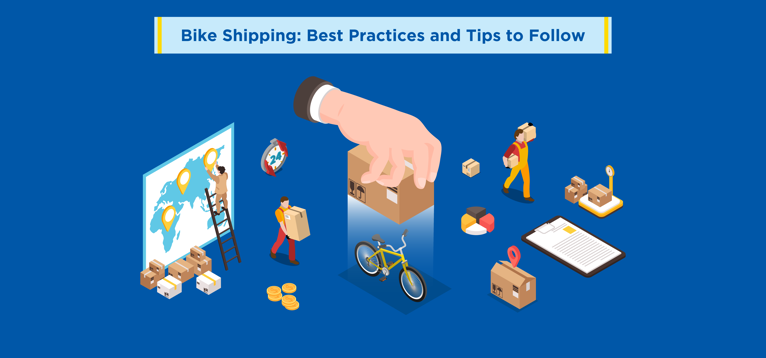A fact known to anyone who's tried to send a bike across the miles—bike shipping is far from simple.
If you've ever attempted to ship a bike to a friend or yourself, you may be familiar with the complexities. And if you are a bike retailer, well, your challenge just multiplied many times.
Think about it. Over the past year, bicycle sales have defied pandemic odds and solidified cycling's position as a lasting passion.
Australia, for instance, witnessed unprecedented bike sales of 1.75 million in FY 20-21. Even more remarkable is that the momentum has remained strong in FY 21-22.
Bike sales continue to soar by over 30% compared to pre-COVID levels. The general manager of Bicycles Industry Australia, Peter Bourke, confidently predicts yet another surge as the festive season approaches.
And that's terrific news for retailers!
However, shipping bikes presents its own set of unique challenges.
They're bulky, expensive, fragile, and highly susceptible to theft. Thus, getting their packaging right is crucial. Yet, with order numbers soaring, the temptation to take shortcuts in the packing process grows stronger.
This challenge is magnified for businesses new to the bike shipping game. They're eager to do it right while minimising costs wherever possible.
Thus, in a world where innovative shipping solutions are just a click away, bike shipping remains a nuanced endeavour. That's where our guide comes in.
Today, we'll unlock the best practices and tips to make bike shipping as smooth as a ride on a sunny day. Whether you're an individual shipping a bike to another state, or a company grappling with bike shipping challenges, we've got you covered.
Exploring Different Bike Shipping Methods
When it comes to bike shipping, you have various options to choose from. The method you select depends on factors such as the budget, distance, urgency, and destination. So do your research before making a decision.
Here are a few standard bike delivery methods:
1. Local Bike Shop
Your local bike shop is a top choice for bike shipping within your city or a neighbouring area. They're experts at packing bikes for shipping and can even disassemble and pack your bike. You could even send the bike directly to another shop for hassle-free reassembly.
2. Shipping via Airlines
Airlines often offer bike shipping, but you must consider baggage allowance, fees, and potential delays. Different airlines have varying bike policies. Some might accept your bike bag within your baggage limit, while others could ask for an extra fee. Sometimes, upgrading your class might be cheaper than adding excess baggage.
If you have to switch flights on different airlines, ensure both will take your bike on board. For safety, get bike insurance – airlines don't cover the damage.
3. Shipping Carriers
Consider partnering with experts in heavy and oversized item shipping. Look for reliable shipping companies handling bulky shipments or moving services. Renowned shipping carriers like PACK & SEND are popular choices for shipping bikes. They offer convenient and reliable services, allowing you to track your shipment throughout its journey.
4. Specialised Bike Shipping Services
Bike shipping companies are experts in long-distance bike delivery. They team up with parcel carriers and pass on volume discounts to you due to the sheer number of bikes they handle. All you have to do is—pack your bike, book the shipment, and choose a pickup or drop-off.
5. Third-Party logistics company
If bike shipping is a regular part of your eCommerce business operations, why not hand it to the pros? Connect with 3PL specialists like PACK & SEND. They have the know-how and resources to ensure your order fulfilment runs smoothly. Plus, they are aces at handling delicate and bulky items, ensuring safe and timely delivery.
6. Air Freight vs Ground Transportation
Consider the urgency of bike delivery when choosing between air freight and ground transportation. Air freight is faster but can be costlier, while ground transportation might take longer but could be more budget-friendly.
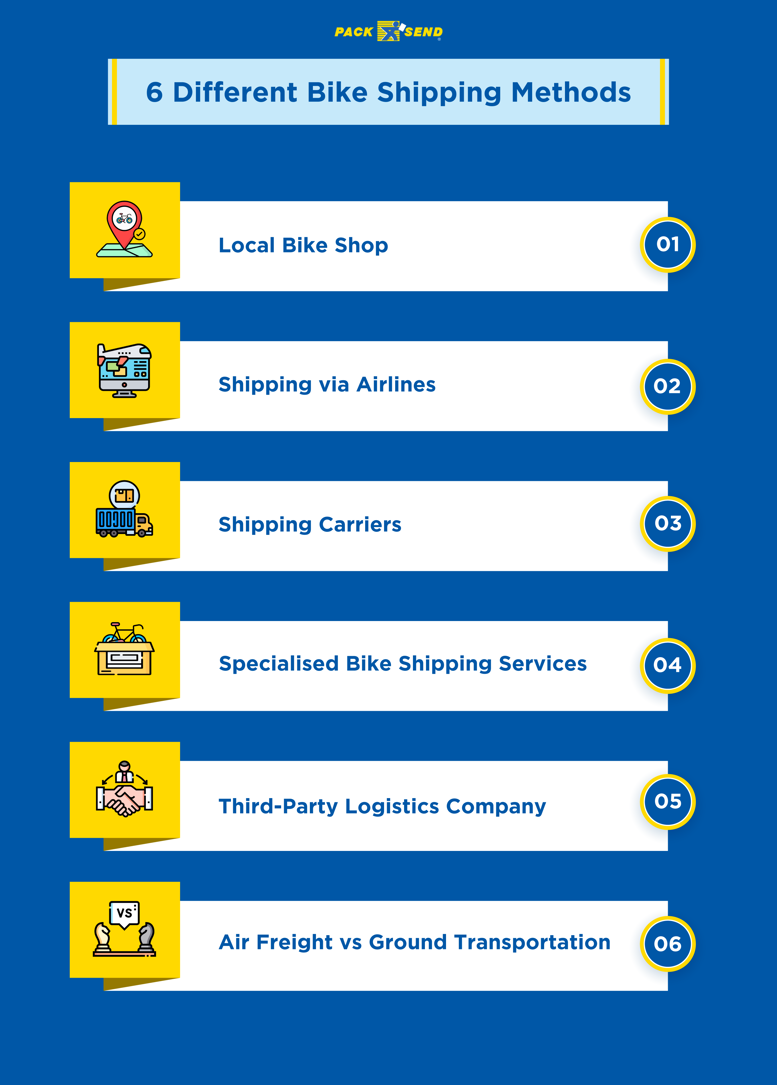
Considerations for International Bike Shipping
International bike shipping requires additional considerations, including customs regulations, import taxes, and documentation. Choosing a carrier with experience in international shipping can simplify this process.
Packing Supplies You’ll Need for Shipping Bike
Before you begin packing the bike for shipping, gather the necessary supplies to ensure its protection during transit:
- Bike shipping box or bag or hardshell cases
- Zip ties
- Water-activated tape (WAT) for packing
- Allen wrenches
- Pedal wrench
- Scissors or utility knife
- Cushioning material, such as foam padding, bubble wrap, or air pillows
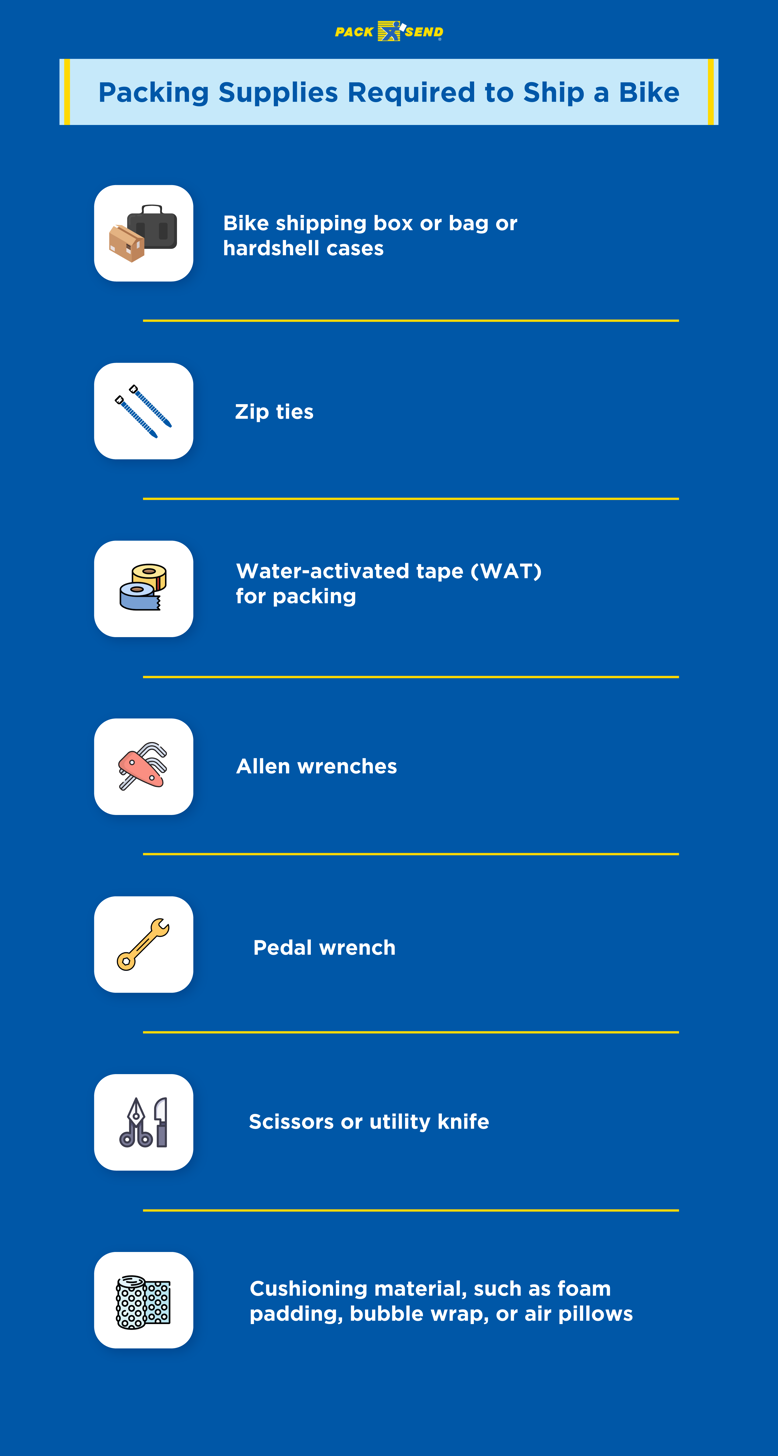
Picking the Right Bike Shipping Container
When it comes to shipping bikes, you have a few container options:
1. Cardboard Bike Shipping Box
Cardboard bike shipping boxes are often the budget-friendly pick, available either for free or for a small fee from local bike shops. Despite their lightweight, they're surprisingly sturdy and, when packed well, offer solid bike protection.
Light and compact, they'll keep shipping costs down due to their manageable weight and size. They're a smart choice for selling a bike or planning a one-way trip where you can access another box at the destination.
2. Soft Bike Bags
Soft bike bags strike a balance between cardboard boxes and hardshell cases. They're lighter and more compact than hardshell cases, making them convenient for transport. Yet, they provide more protection than cardboard boxes, shielding your bike.
3. Hardshell Cases
For top-notch protection, hardshell cases are the go-to. They come at a higher cost (both in purchasing and shipping due to their weight).
However, they're worth it if you're shipping frequently or dealing with high-value bikes. With built-in padding, hardshell cases shield your bike from impact shipping damage effectively.
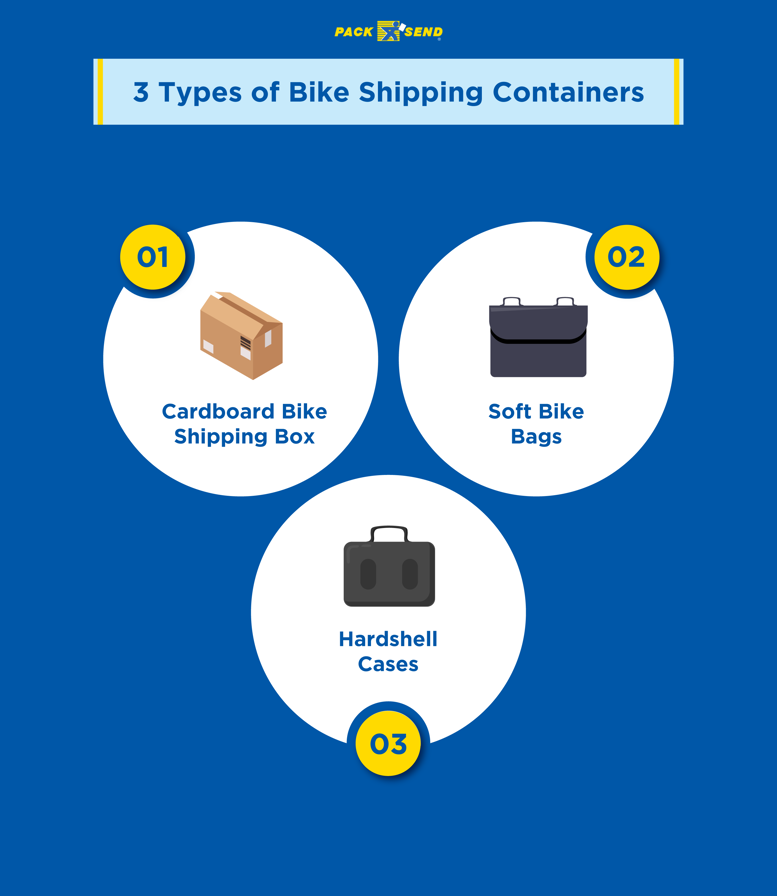
Disassembling Your Bike Before Bike Shipping
Disassembly is vital for a secure fit and to reduce the risk of damage during bike shipping. Plus, it also makes packing cargo for shipping a breeze. While the steps might vary depending on your bike's type, here’s the simple breakdown:
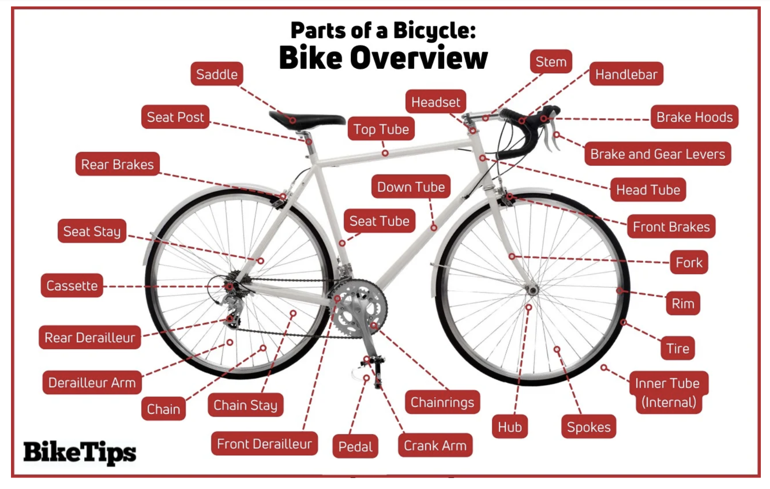
Step 1. Pedals
By taking apart the pedals, you're getting your bike ready to fit neatly into the moving bike shipping box.
Grab a pedal wrench and detach both pedals. Twist the left pedal clockwise to unscrew; for the right, go anti-clockwise. Once they're off, wrap them up in bubble wrap or foam and tuck them into a small packing box or bag.
Step 2. Saddle and Seatpost
Start by loosening the seat post. It'll come out along with the seat. Pack them together as a unit, using bubble wrap to keep them snug during the move. Wrap them thoroughly and then use packing tape for extra security.
Place this packed unit in the cardboard box where you stored the pedals. To keep the seatpost from damaging other bike parts, you can zip-tie them to the frame or tape them to the inside of the bike shipping box.
Step 3. Handlebars
To detach the handlebars, begin by unscrewing the stem bolts. This releases the handlebars from the stem.
Afterwards, put the stem bolts back in place, leaving the stem on the bike. But, if feasible, you can remove the stem and the handlebars together.
To remove the handlebars, unscrew the stem bolts, which open up the stem and let you release the handlebars.
Put the handlebars on the floor alongside the stem (if you removed them). They'll need a snug setup before you pack your bike into the cardboard box.
Step 4. Front Brake
Before removing the front wheel, your front brake must step aside. This process is a tad intricate and requires precision, so take your time.
Start by removing the front brake from the fork. After removal, pop the nut back in place and wrap the entire front brake unit with wrapping paper. Seal it securely using packing tape.
It’s best to leave the cables untouched; adjusting them post-move can be tricky. Instead, disconnect one side of the brake from the cable. Lastly, keep everything snug by using bubble wrap and tape.
Step 5. Remove the Front Wheel
With the front brake already out of the picture, this step will only take a few minutes. Now, unscrew the front wheel bolts, and the wheel will come off without a hitch. Pad the wheel using foam, ensuring it's cushioned. Secure it with cardboard within the box or utilise padded wheel bags.
Keep the rear wheel attached to the frame if your bike box allows it. But be sure to cover the cassette with foam to prevent damage to other components.
Install end caps over axle ends for both wheels to prevent damage to the box or other parts. If possible, consider removing skewers, thru-axles, and rotors.
Step 6. Derailleur and Hanger
Remove the derailleur and hanger and wrap them in thick padding. Then, secure them inside the frame with tape or zip ties.
But if you can't remove them, shift the rear derailleur to the easiest gear. Cover it with bubble wrap and cardboard for added protection. Secure the bundle with packaging tape or zip ties.
Step 7. Bike Accessories
Remove all bike add-ons, such as fenders, mirrors, racks, bells, etc., to prevent jostling during the journey. Before placing them in a packing box, give each accessory its protective wrap.
Step 8. Partially Deflate the Tires
Deflating tires makes packing more manageable and ensures that they won't be under high pressure during the ride. Although, avoid fully deflating them. Complete deflation can lead to rim scratching during bike shipping.
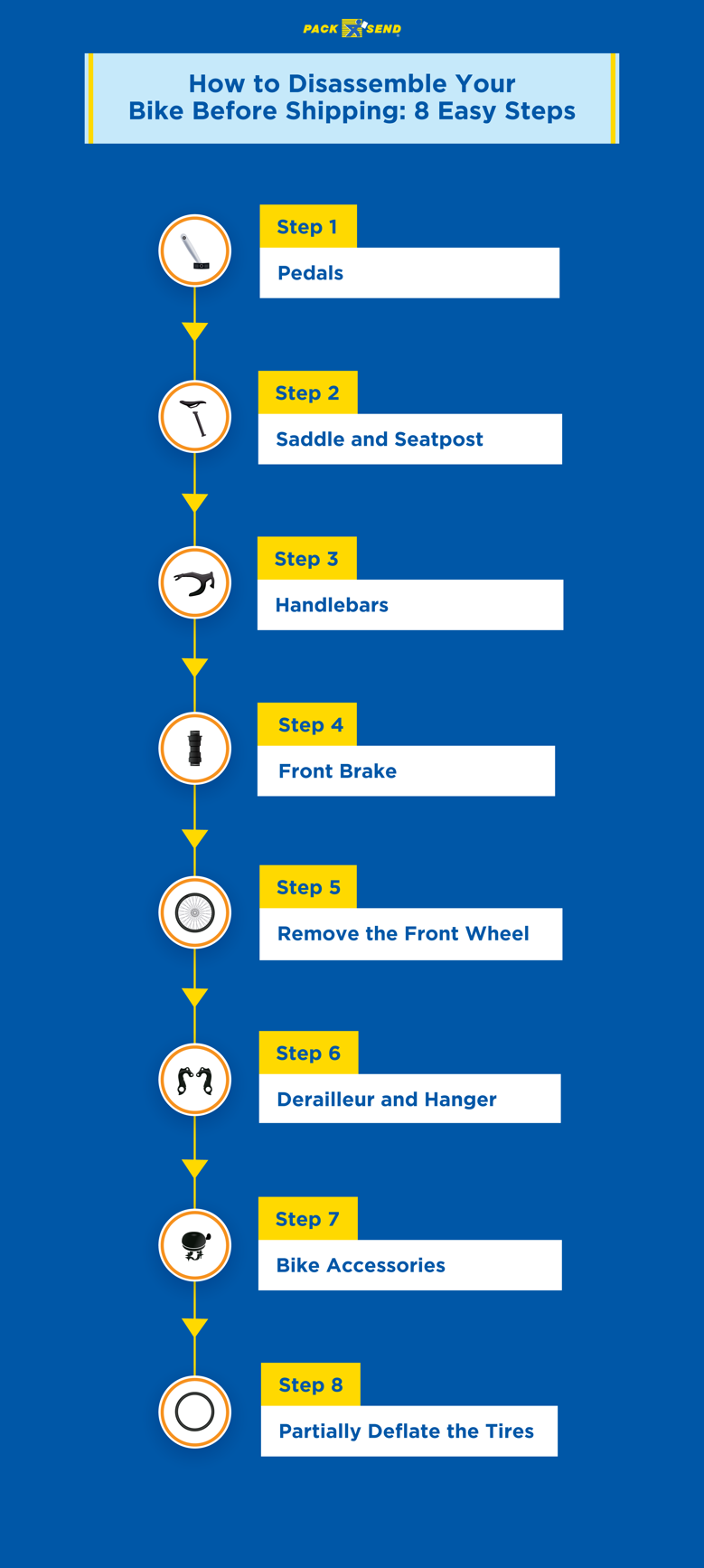
The Process of Packing a Bike for Shipping
Great job on getting your bike ready! Now, let's get it safely packed and boxed up for the journey ahead. By meticulously packing the bike for shipping, you ensure that it withstands the rigours of transportation.
Witness the art of secure bike packing in action! Head to PACK & SEND's Facebook video for a step-by-step guide on ensuring safe bike shipping.
1. Select the Correct Bike Shipping Box for Your Bike’s Size
Find a suitable box from your local bike shop or courier's website. Ensure it fits your bike well and provides enough space. Seal the bottom edges of the box with at least 2" wide packing tape and stand the box upright.
2. Cushion the Base
Place bubble wrap, cardboard, or packaging peanuts on the box's bottom. This shields your bike from knocks during transit.
3. Protect the Bike Frame
Start by covering exposed metal parts with foam pads or tubes to prevent metal-to-metal friction. Then, secure the foam with packing tape or zip ties. For added protection, use soft padding generously to guard against damage.
4. Place the Parts inside the Bike Shipping Box
-
Begin with the essentials. Put the frame and rear wheel in the box first.
-
Insert a cardboard divider between the frame and the wheel.
-
Gently slide the remaining parts close to the frame.
-
Fill any gaps with packing peanuts or cardboard.
-
Close the container and give it a shake. If you hear movement, reorganise by adding extra padding or zip ties as needed.
5. Seal and Label
Apply packing tape (at least 2" wide) around the box's top edges. For extra strength, add a strip of tape around the centre.
And remember, Print three shipping labels from your courier's website—two for outside, one for inside.
Attach two labels on opposite sides, covering the edges but not the barcode. If you're using a travel case, fix labels with shipping luggage tags. Keep an extra label inside for added assurance.
Finally, to highlight fragility, mark the box "Fragile" and indicate "This Side Up" for careful handling.
Your bike is now ready to set off securely.
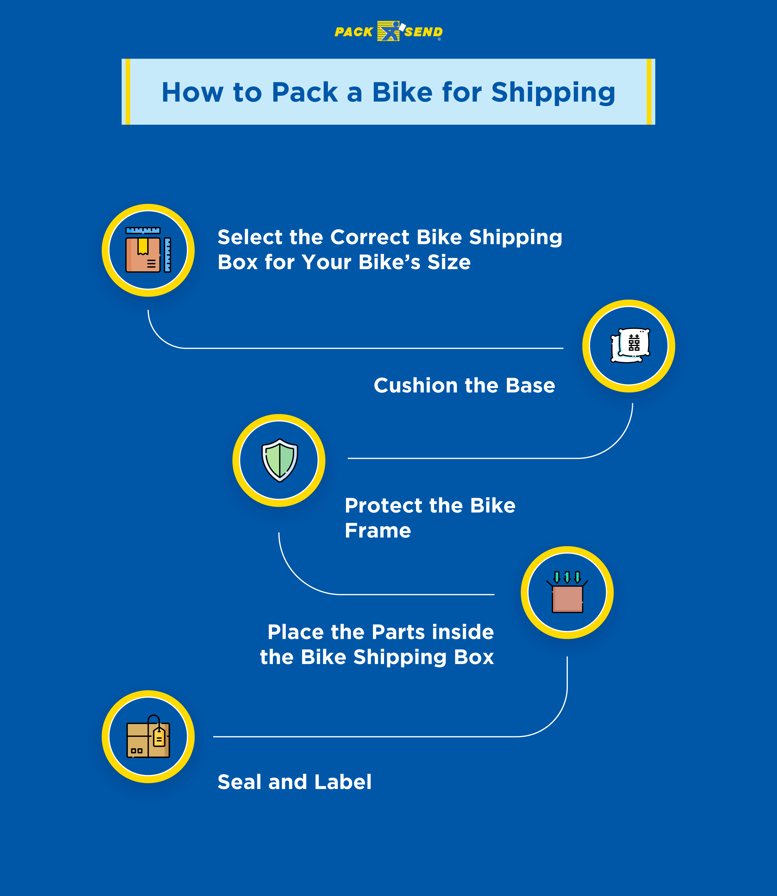
Documentation and Labelling for Bike Shipping
When shipping bikes, having the right documentation and clear labelling is like having a trusty map and compass. Just as a well-packed bike ensures its safe transit, meticulous attention to documentation and labelling streamlines the process. It reduces the risk of errors and provides a seamless experience for both sender and recipient.
These practical steps help ensure your bike's smooth journey, leaving no room for hiccups.
1. Getting the Details Right
The journey begins with paperwork – the essential roadmap for your bike's travels. Before you even start disassembling your bike, ensure you have all the necessary documents ready. Depending on your shipping method and carrier, you may need to provide information such as addresses, contact details, and tracking numbers.
2. Labelling for Clarity
Proper labelling ensures that your bike is handled carefully and reaches its destination on time. When affixing labels, use clear and legible handwriting or print them neatly to avoid confusion. Include:
-
The sender's and recipient's addresses
-
Contact information
-
Any specific instructions related to handling or storage.
-
Fragile Items? Shout It Out
For bikes with delicate or high-value parts, communicate this through special instructions and fragile labels. "Handle with Care'' labels catch freight handlers' attention and prompt them to exercise caution. And minimising the risk of damage during the bike shipping process.
3. The Shipping Label
The shipping label is like your bike's boarding pass to its destination. It holds all the vital information, such as the shipping company, tracking number, and other relevant details. So, make sure it's attached securely and visible for smooth tracking and easy identification.
4. Documentation for Insurance
If you opt for shipping insurance, proper documentation becomes even more crucial. Take clear and detailed photographs of your bike from various angles before disassembly. This photographic evidence can serve as a reference point in case of any damage claims. Keep a record of the bike's value and any additional accessories being shipped along with it.
5. Backup Documentation
It's always wise to include duplicate copies of essential documents inside the packaging. If the external labels become damaged or illegible during transit, having internal documentation ensures that the carrier can still identify and route your bike correctly.
Safeguarding and Monitoring Your Shipment While Shipping Bikes
Insurance Coverage
When shipping your bike, consider getting insurance to protect against potential damage or loss during transit. This is particularly valuable when you are shipping bikes overseas.
Stay Informed with Tracking
Utilise tracking services to monitor your bike's location and delivery progress, ensuring a smooth and worry-free bike shipping process.
Customs Compliance
Accurate customs forms for international bike shipping to prevent delays at customs checkpoints.
Dealing with Issues
In case of damage or loss, insurance provides coverage for the cost. If uninsured, work directly with the courier to address any problems.
Following these steps guarantees a secure and seamless shipping experience for your bike.
Shipping Electric Bikes
With the surge in environmental awareness and fuel costs, the demand for eco-friendly transportation like eBikes has rocketed. They present an enticing solution for longer commutes and offer accessibility for those with mobility challenges. What’s more, they are gaining traction for leisure use, now widely available for rent in bustling city centres and popular tourist spots.
The eBike market, valued at $26.5 billion in 2021, is poised for impressive growth. With an anticipated annual increase of nearly 10% until 2030, it is estimated to reach around $62.3 billion.
So, understanding the bike shipping drill is paramount if you're part of the eBike industry. Why? Well, partly because these eBikes play by different rules compared to regular bicycles, thanks to their heavier bodies and battery-powered engines.
But here’s where the real twist comes in—the lithium battery. They are why eBike shipping must comply with lithium batteries shipping regulations.
-
Lithium batteries, which couriers label as dangerous goods, are highly flammable, waiting to ignite
-
Their sensitivity to environmental conditions increases risk
-
The potential for short-circuiting is high
Given all this, retailers and couriers must grasp how to adhere to regulations for handling both the bike and its lithium battery.
But navigating these shipping regulations isn't a job for the faint-hearted. As a result, many postal and courier companies hesitate to handle packages with lithium batteries.
But fret not! Enter PACK & SEND! with its 100+ Service Centres across Australia and an ever-expanding global network. We've cracked the code on custom packaging, freight expertise, and logistics services. We're all about navigating those global restrictions and regulations, giving you the ultimate convenience and peace of mind.
It’s also vital to choose the appropriate shipping mode. Air freight, though more complex due to documentation and carrier approvals, are possible. Ground services might serve well for domestic eBike shipping, while ocean freight suits international transport better.
How to Ship Ebikes with Lithium Batteries Installed?
Most eBikes have lithium batteries, which couriers approach cautiously due to safety concerns. To ship such an eBike:
-
Determine battery type (lithium metal or lithium-ion), as handling varies
-
Obtain approval from the courier, airline, and potentially national authorities, such as The Civil Aviation Safety Authority (CASA) and The International Air Transport Association (IATA)
-
Ensure the battery's condition and careful packing
-
Attach a “Dangerous Goods" label
-
Follow precise packaging in adherence to specific guidelines. It’s best to have a certified professional pack the eBike
-
There may be potential requirements for a HazMat-certified individual to handle packaging
Gathering the requisite documents and certifications is another crucial step. Some essential paperwork includes:
-
Dangerous Goods Contract: Certain couriers could require a distinct agreement for shipping items containing lithium batteries.
-
Material Safety Data Sheet (MSDS): Required for shipments with potentially hazardous materials, often requested by airlines or couriers.
-
UN38.3 Certificate: Often demanded as proof of battery testing compliance with UN standards for safe transport.
-
Certificate of Origin from the eBike's manufacturing origin.
-
Certificate for the Safe Transport of Goods for shipment safety verification.
-
Customs Clearance Paperwork for international shipping.
However, remember that acquiring these approvals, documents, and certificates takes time. The process can stretch for months, assuming all tests and inspections go smoothly. Some records remain valid for only a year, so meticulous planning is essential.
How to Ship eBikes with Their Lithium Batteries Removed?
Removing the lithium battery from your eBike before shipping can simplify the process. It allows the eBike to be treated like any regular non-hazardous item. On the other hand, two shipments will incur costs if you choose to ship the eBike battery separately.
Nevertheless, the battery must still reach the customer. To manage this, you must work with a reputable courier experienced in handling such goods.
When it comes to shipping lithium batteries separately, there are some important rules to follow:
-
If your lithium batteries weigh more than 35kgs, you'll need approval from the national authority before you can ship them.
-
Affix a “Dangerous Goods” label.
-
Obtaining P1965 certification, which verifies your battery's safety for transit, could be necessary.
-
Pack your battery terminals with non-conductive materials to prevent short-circuiting during their journey.
-
Pack your batteries carefully with padding materials to maintain stability. To ensure safety, don't cut corners on specialised packaging.
How Much Does It Cost to Ship A Bike?
Shipping a bike comes with varying costs influenced by various factors. For domestic shipments, the average cost can fall between $50 and $250. If you're sending it abroad, it starts around $200 and could go over $500.
Factors affecting bike shipping costs include:
-
Distance: Shipping internationally is pricier, making local shipping a more economical option.
-
Bike Weight and Dimension: Larger or heavier bikes incur higher costs.
-
Additional Services: Extra features, like expedited shipping or insurance.
Remember, if you're sending internationally, you must pay more for customs fees. Don't forget to factor in additional expenses like protective packing materials for the bike frame, a shipping box or case, and any assembly services required after the bike is picked up. Nonetheless, some providers might offer discounts for bulk shipments or early bookings.
While cost is a factor, prioritise a reputable bike shipping company to ensure safe and timely bike delivery.
Conclusion
In the world of bike shipping, the journey isn't always smooth. The recent surge in bike sales has only intensified the game. Australia alone saw a phenomenal increase in bike sales, defying pandemic odds. With over 30% growth compared to pre-COVID levels, bikes are pedalling towards a brighter future.
Whether you're a cycling enthusiast or running a bike retail business, the complexities of bike shipping are undeniable.
From bulky frames to delicate components, every aspect demands attention. And then there's the lithium battery, a pivotal part of eBikes, elevating bike shipping challenges due to safety concerns.
Enter PACK & SEND, your trusted partner in this complex journey. With over 100 Service Centres and a global network, we've honed the art of packaging, freight solutions, and logistics.
We recognize that every bike is one-of-a-kind. Our packaging experts meticulously tailor packaging solutions guarding them against the rigours of transit. Our comprehensive eCommerce logistics solutions are tailored to streamline operations, ensuring seamless customer from order to delivery. With our guidance, you can skillfully navigate the intricate landscape of bike shipping without compromising safety or efficiency.
Ready to embark on a hassle-free bike shipping journey? Reach out to us today, and let PACK & SEND be your guide. Your bikes deserve the best, and we're here to ensure they arrive safely and on time.
Frequently Asked Questions (FAQs)
1. How to Pack a Bike for Shipping?
Packing a bike for shipping involves several steps. Here's an essential guide:
-
Disassemble the bike.
-
Protect fragile parts from damage by covering them with foam padding.
-
Place in a suitable container. Choose between cardboard bike shipping boxes, soft bike bags, or hardshell cases.
-
Add bubble wrap or packing peanuts to the box's bottom for added protection.
-
Securely place parts inside the box with appropriate padding.
-
Seal the box, affix shipping labels, and mark it as fragile if needed.
2. Which Transport Mode is Cheaper to Ship a Bike?
The cost-effectiveness of shipping modes depends on factors like distance, urgency, and destination. Ground transportation is generally cheaper for domestic shipping, while air freight is faster but can be costlier. Consider the trade-offs and your specific needs when choosing between the two.
3. What is the Best Way to Ship a Bicycle?
The best way to ship a bike depends on your preferences and requirements. Some common methods include:
-
Local bike shops for short-distance shipping within your city or nearby areas.
-
Reliable shipping carriers.
-
Specialised bike shipping services like BikeFlights, ShipBikes, or TriBike Transport for long-distance delivery.
-
Third-party logistics companies like PACK & SEND for seamless eCommerce bike shipping solutions.
4. Where Can I Buy a Bike Shipping Box?
You can buy a bike shipping box at a local bike shop or online. Some moving companies sell bike boxes. And most specialty bike shippers like BikeFlights.com or ShipBikes.com will sell bike boxes online. Ensure the box suits your bike's size and offers the necessary protection for safe bike shipping.
Count on PACK & SEND for a full range of boxes and packing materials in various sizes. Learn about the packaging supplies you need from our experts.
5. Should I Insure My Bike When Shipping It?
Absolutely, it's a prudent choice to consider insuring your bike when shipping it. Insurance provides a safety net in case your bike is lost, stolen, or damaged during transit. Many carriers include basic insurance coverage as part of their bike shipping services. If the basic insurance coverage doesn't match the value of your bike, you can typically purchase additional insurance for an extra fee.
